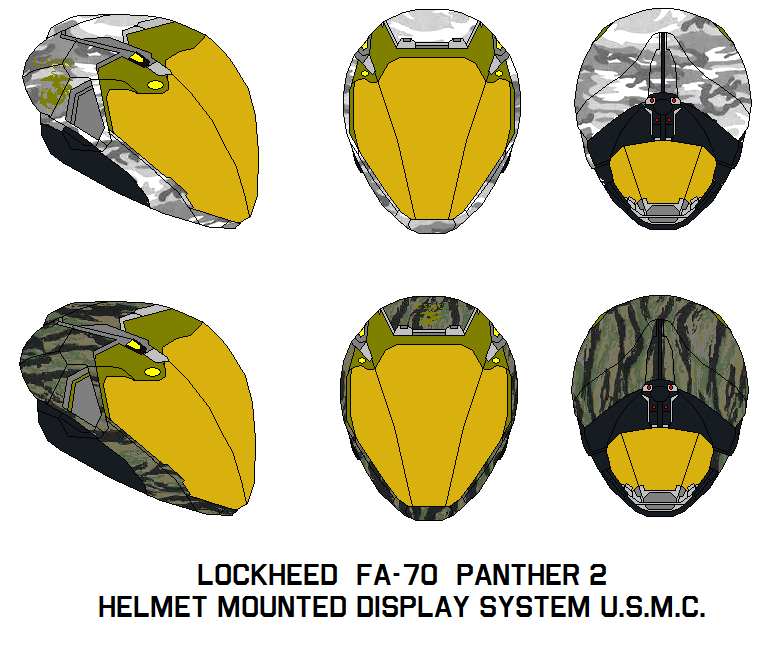ShopDreamUp AI ArtDreamUp
Deviation Actions
Suggested Deviants
Suggested Collections
You Might Like…
Featured in Groups
Description
A helmet-mounted display (HMountD - pronounced "H-mount-D") is a device used in some modern aircraft, especially combat aircraft. HMDs project information similar to that of head-up displays (HUD) on an aircrew’s visor or reticle, thereby allowing him to obtain situational awareness and/or cue weapons systems to the direction his head is pointing. Applications which allow cuing of weapon systems are referred to as helmet-mounted sight and display (HMSD) or helmet-mounted sights (HMS).
Aviation HMD designs serve these purposes:
using the pilot's eye (actually head angle) as a pointing device to direct air-to-air and air-to-ground weapons seekers or other sensors (e.g., radar, FLIR) to a target merely by pointing his head at the target and actuating a switch via HOTAS controls. In close combat prior to HMDs, the pilot had to align the aircraft to shoot at a target. HMDs allow the pilot to simply point his head at a target, designate it to weapon and shoot.
displaying targeting and aircraft performance information (such as airspeed, altitude, target range, weapon seeker status, "g", etc.) to the pilot while "heads-up", eliminating the need to look inside the cockpit.
displaying sensor video for the purpose of:
verification that the chosen sensor has been cued to the right target or location without requiring the pilot to look inside the cockpit
viewing outside terrain using sensor video in degraded visual conditions.
HMD systems, combined with High Off-Boresight (HOBS) weapons, results in the ability for aircrew to attack and destroy nearly any target seen by the pilot. These systems allow targets to be designated with minimal aircraft maneuvering, minimizing the time spent in the threat environment, and allowing greater lethality, survivability, and pilot situational awareness.
VSI is developing the QuadEyeTM Night Vision Cueing & Display (NVCD) for the US Navy and US Air Force, and is also producing the DASH Generation IV HMD.
Eye tracking – Eye trackers measure the point of gaze relative to the direction of the head, allowing a computer to sense where the user is looking. These systems are not currently used in aircraft.
Direct retinal projection – Systems that project information directly onto the wearer’s retina with a low-powered laser (virtual retinal display) are also in experimentation.
Aviation HMD designs serve these purposes:
using the pilot's eye (actually head angle) as a pointing device to direct air-to-air and air-to-ground weapons seekers or other sensors (e.g., radar, FLIR) to a target merely by pointing his head at the target and actuating a switch via HOTAS controls. In close combat prior to HMDs, the pilot had to align the aircraft to shoot at a target. HMDs allow the pilot to simply point his head at a target, designate it to weapon and shoot.
displaying targeting and aircraft performance information (such as airspeed, altitude, target range, weapon seeker status, "g", etc.) to the pilot while "heads-up", eliminating the need to look inside the cockpit.
displaying sensor video for the purpose of:
verification that the chosen sensor has been cued to the right target or location without requiring the pilot to look inside the cockpit
viewing outside terrain using sensor video in degraded visual conditions.
HMD systems, combined with High Off-Boresight (HOBS) weapons, results in the ability for aircrew to attack and destroy nearly any target seen by the pilot. These systems allow targets to be designated with minimal aircraft maneuvering, minimizing the time spent in the threat environment, and allowing greater lethality, survivability, and pilot situational awareness.
VSI is developing the QuadEyeTM Night Vision Cueing & Display (NVCD) for the US Navy and US Air Force, and is also producing the DASH Generation IV HMD.
Eye tracking – Eye trackers measure the point of gaze relative to the direction of the head, allowing a computer to sense where the user is looking. These systems are not currently used in aircraft.
Direct retinal projection – Systems that project information directly onto the wearer’s retina with a low-powered laser (virtual retinal display) are also in experimentation.
Image size
767x649px 140.91 KB
Comments5
Join the community to add your comment. Already a deviant? Log In
This look cool, but they already made HUD's for the military.














![FuSPz Panther [K2]](https://images-wixmp-ed30a86b8c4ca887773594c2.wixmp.com/f/c8c42564-416b-44ce-97b3-c549c8b703bc/de8vsn5-28c96a7d-3b0e-4c66-879e-ae8248f1c0b8.png/v1/crop/w_92,h_92,x_15,y_0,scl_0.44660194174757,q_70,strp/fuspz_panther__k2__by_kacper444_draws_de8vsn5-92s.jpg?token=eyJ0eXAiOiJKV1QiLCJhbGciOiJIUzI1NiJ9.eyJzdWIiOiJ1cm46YXBwOjdlMGQxODg5ODIyNjQzNzNhNWYwZDQxNWVhMGQyNmUwIiwiaXNzIjoidXJuOmFwcDo3ZTBkMTg4OTgyMjY0MzczYTVmMGQ0MTVlYTBkMjZlMCIsIm9iaiI6W1t7ImhlaWdodCI6Ijw9MjA2IiwicGF0aCI6IlwvZlwvYzhjNDI1NjQtNDE2Yi00NGNlLTk3YjMtYzU0OWM4YjcwM2JjXC9kZTh2c241LTI4Yzk2YTdkLTNiMGUtNGM2Ni04NzllLWFlODI0OGYxYzBiOC5wbmciLCJ3aWR0aCI6Ijw9MzQ0In1dXSwiYXVkIjpbInVybjpzZXJ2aWNlOmltYWdlLm9wZXJhdGlvbnMiXX0.E2axFkFpqItk8zz_ieWBiYnhIYogXz0oYX5bNjBVSFY)
![SPW-66R [ABS]](https://images-wixmp-ed30a86b8c4ca887773594c2.wixmp.com/f/c8c42564-416b-44ce-97b3-c549c8b703bc/del95vi-3c7c02c2-e87d-46e1-92ed-26524b01a0c8.png/v1/crop/w_92,h_92,x_17,y_0,scl_0.39484978540773,q_70,strp/spw_66r__abs__by_kacper444_draws_del95vi-92s.jpg?token=eyJ0eXAiOiJKV1QiLCJhbGciOiJIUzI1NiJ9.eyJzdWIiOiJ1cm46YXBwOjdlMGQxODg5ODIyNjQzNzNhNWYwZDQxNWVhMGQyNmUwIiwiaXNzIjoidXJuOmFwcDo3ZTBkMTg4OTgyMjY0MzczYTVmMGQ0MTVlYTBkMjZlMCIsIm9iaiI6W1t7ImhlaWdodCI6Ijw9MjMzIiwicGF0aCI6IlwvZlwvYzhjNDI1NjQtNDE2Yi00NGNlLTk3YjMtYzU0OWM4YjcwM2JjXC9kZWw5NXZpLTNjN2MwMmMyLWU4N2QtNDZlMS05MmVkLTI2NTI0YjAxYTBjOC5wbmciLCJ3aWR0aCI6Ijw9NDAxIn1dXSwiYXVkIjpbInVybjpzZXJ2aWNlOmltYWdlLm9wZXJhdGlvbnMiXX0.a-BSc_qWa16MKzCllFXcCIE7cEcDUPVhlwuG8qsGk7M)


![Sikorsky UH-60L Black Hawk ortho [new]](https://images-wixmp-ed30a86b8c4ca887773594c2.wixmp.com/f/e0dc8eb0-7eb3-4716-b7a1-4364a45acdc0/d7sbu7k-93ce24f8-a1c9-4ae0-9a1a-98fe61c1c913.jpg/v1/crop/w_92,h_92,x_14,y_0,scl_0.0368,q_70,strp/sikorsky_uh_60l_black_hawk_ortho__new__by_unusualsuspex_d7sbu7k-92s.jpg?token=eyJ0eXAiOiJKV1QiLCJhbGciOiJIUzI1NiJ9.eyJzdWIiOiJ1cm46YXBwOjdlMGQxODg5ODIyNjQzNzNhNWYwZDQxNWVhMGQyNmUwIiwiaXNzIjoidXJuOmFwcDo3ZTBkMTg4OTgyMjY0MzczYTVmMGQ0MTVlYTBkMjZlMCIsIm9iaiI6W1t7ImhlaWdodCI6Ijw9MjUwMCIsInBhdGgiOiJcL2ZcL2UwZGM4ZWIwLTdlYjMtNDcxNi1iN2ExLTQzNjRhNDVhY2RjMFwvZDdzYnU3ay05M2NlMjRmOC1hMWM5LTRhZTAtOWExYS05OGZlNjFjMWM5MTMuanBnIiwid2lkdGgiOiI8PTQwMDAifV1dLCJhdWQiOlsidXJuOnNlcnZpY2U6aW1hZ2Uub3BlcmF0aW9ucyJdfQ.X0cApnCAEGEGbYPAU8aw2FBpPAjEr_nDn-oaSfqB2Xk)

















